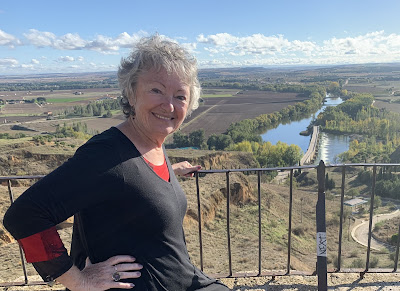The Rio Duero flows through Spain and on through Portugal to the Atlantic Ocean. And it is synonymous with wine, vineyards, farming, Zamora, Castilla y León and more, more, more.
I saw this view for the first time ten years ago during my first trip to Toro, one of our ancestral villages here in Spain. Then, the same as now, seeing the valley stretched before me with the Duero River far below is still thrilling. The panoramic view goes for miles in all directions. Tomorrow, I plan to walk down to the bridge and the water. It will take me longer coming back up the hill, but I tell myself it will be worth it.
Without a strong internet in several of the villages we stayed in over the past week, I have not been able to post any notes about the stunning congreso filled with other historians and authors like myself. For me, meeting so many other like-minded people from around Spain and the United States, I will take away good memories. Despite being nervous about my presentation about my book, The Girl Immigrant and my research to write it, everything went smoothly and I am glad it is over. Sharing our ancestral immigration stories never gets tiresome for us.
The local costumes and dances differed in each town. I tried to dance to all of them. I do not think I can remember ever seeing so many happy people; smiles, laughter and music. This particular event was In Montehermoso, not far from Coria where we walked our legs off going through the streets and looking into old doorways and archways.
And then the door knockers here in Toro. We walked toward Plaza de San Francisco with our Toro map to find the bull ring. Along that street, the doors were so old and the knockers were so unique, I kept focusing on the doors and we nearly missed the Plaza de Toros, which is now used for musical events. The “hand” knockers have fascinated me for years and these were antiques along with their peeling doors. But they are also wonderful. My shiny brass hand knocker on my own door is a shadow of these. Note the top left knocker. Amazing.

When I told Steven about the underground wine bodega that my cousins showed me beneath his friend’s shop here in Toro, we decided to retrace my steps. The young shop worker is a 4th generation shopkeeper and despite being nervous with his English, he did very well between our Spanish and his explanations. He led us deep into the bowels of the earth beneath the shop, in what was once a house. He said at one time there were about 300 of these underground bodegas where grapes were pressed into wine in an elaborate and complicated ritual along with their water storage. 3,000 liter barrels were at the bottom of the very steep stone steps and then the large press and a smaller press (200 years old). Bottles of wine were in shelves and on tables. I saw a thick rope hanging from a deep ceiling hole and he said that is used to pull up buckets of water. He was speaking English much better after twenty minutes and his nervousness seemed to disappear.


While my brother Steven works every evening in the privacy of the hotel room, I wander through the labyrinth of Toro, feeling the spirit of my great grandmother Rita Trascasas Marzo (Silván) and the families before her.
Like dessert, I saved the best until last: Her name is Mercedes Trascasas, my cousin and kindred spirit.
Seeing my Trascasas cousins again was a lovely, sweet time as we exchanged stories, memories and enjoyed an elaborate meal at a new restaurant on the outskirts of town. Pulpa (octopus) from Galicia served on potato slices with partially melted cheese on top was the appetizer. And the main dishes kept coming…bacalao (cod) after a bean soup and the best bread ever. And rice pudding, arroz con leche…And wine.
Tomorrow, we drive to Fuentesauco to visit Francisco “Paco” Hidalgo, a Silván descendant that I met in 2019 with the help of Mercedes and her husband Jenaro Costas and their daughter, Cintia. Another adventure to walk-in Abuelita’s footsteps.
 Paco does not know anything about his family on his abuela Clara Silván García side of the family tree. So, seeing the family immigration story listing Silván names took his breath away and brought tears to his eyes. He shared family names with us and pulled out a metal box filled with photos. He is a proud man, soft spoken and simpatico. His hug and cheek kisses were heart felt and he seemed to be filled with the family spirit like me, wanting to know about our families. I will post on the Silván Facebook sight for further information.
Paco does not know anything about his family on his abuela Clara Silván García side of the family tree. So, seeing the family immigration story listing Silván names took his breath away and brought tears to his eyes. He shared family names with us and pulled out a metal box filled with photos. He is a proud man, soft spoken and simpatico. His hug and cheek kisses were heart felt and he seemed to be filled with the family spirit like me, wanting to know about our families. I will post on the Silván Facebook sight for further information.






















